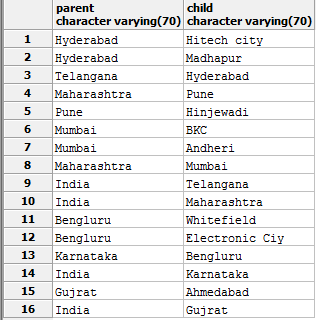
They start with the output of an initial query, which they repeatedly union with the output of the recursive part (the query after the UNION or UNION ALL) until the recursive part adds no rows. Postgresql rekursive Self - Join. A self - join is a query in which a table is joined to itself. Self - joins are useful for comparing values in a column of rows within the same table. To form a self - join , you specify the same table twice with different aliases, set up the comparison, and eliminate cases where a value would be equal to itself.
Recursive joins are often used to obtain parent-child data. Is it possible to use self - joins of the recursive table in a recursive CTE (rCTE)? End the recursion and merge the of the first three steps to get the final WITH RECURSIVE result set. Is there a way to restructure my recursive temporary table such that only the relevant rows are created?
A normal SQL query is not enough for forming this result. You might thing of a giant self JOIN query, but that also fails since the depth here is arbitrary and may change in future. So, for this we use a special query called WITH RECURSIVE. This can be achieved using Common Table Expressions (CTEs).
Using the WITH clause, we can create a temporary table scope of which is bound to that query itself. In this example, as in many real cases, the repetition involves only a single database table, and so is more specifically a recursive self - join. WITH and WITH RECURSIVE in single query. You can think of CTEs as a view that is materialized only while the query is running. Hierarchical data in postgres.
But that selects only templates within level range of the selected category. In such cases, Self JOIN query will fail since the depth here is arbitrary and may change in future. For this, we use a special query called WITH RECURSIVE. Let’s solve this particular problem using recursive queries.
In our case, that would be the top level questions and categories. There is nothing like “ recursive ” self - join in relational systems. I need to write a self join query that pulls the heirarchy of the currently employee.
For instance if I search by object_id=35 then it will pull all relations up to parent id of zero. So it will pull 3and 3from the database also. In case of LEFT OUTER JOIN , an inner join is performed first.
Then, for each row in table Tthat does not satisfy the join condition with any row in table T a joined row is added with null values in columns of T2. It is very often used to compare a table with a version of itself! We will find all the students in our sample DB who have the same test score. Achieving this is really just a matter of.
I was given was always to a. There are over million records in a self -referential database table, where one. Let’s take some examples to understand how the self join works. SQL Server self join examples. Using self join to query hierarchical data.
To construct a self join , you select from the same table twice by using the SELECT statement with an inner join or outer join clause. SQL self join is used to join or compare a table to itself. FROM tree t JOIN recursetree. SQL: inner, cross and self joins Understanding how table joins work is one of the key skills of a database beginner.
In an earlier post , we normalized our ceos table into two tables, one table to list the set of unique people and a second table to associate a person with a term as CEO. Ist es möglich, Selbstverknüpfungen der rekursiven Tabelle in einem rekursiven CTE (rCTE) zu verwenden? Ich habe den folgenden rCTE mit einem Self - Join des rekursiven Terms x. My experience is that it is indeed very well optimized.
Having this specific simple many to many self referential structure. The difference is that these methods use the previously calculated EMA value as a basis rather than the original (non-smooth) data value.
Keine Kommentare:
Kommentar veröffentlichen
Hinweis: Nur ein Mitglied dieses Blogs kann Kommentare posten.